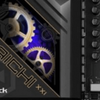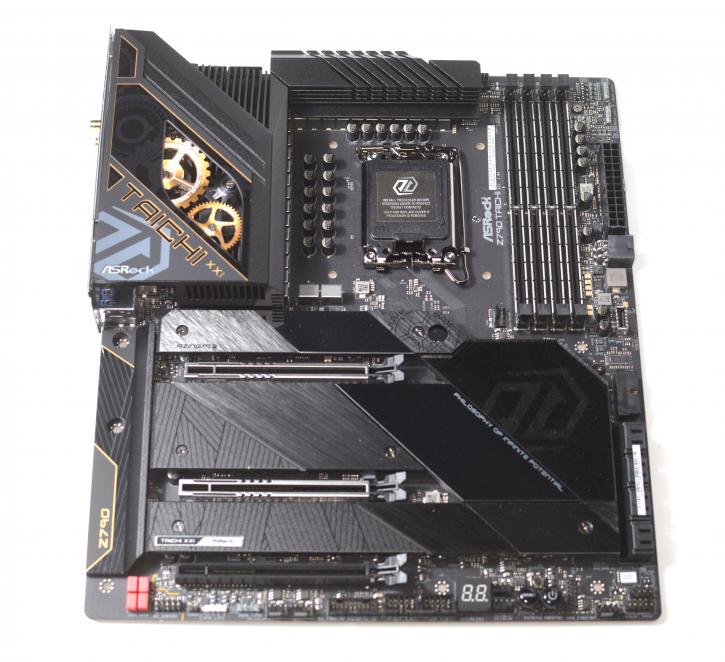Final Words & Conclusion
Conclusion
The ASRock Z790 Taichi is another iteration of a well-known series. This time it’s not a bad thing. The improvements to the Z690 model are much more noticeable than with the predecessor vs. Z590. Additionally – it’s cheaper now! Overall the Z790 is a good motherboard. The looks are great (with the moving cog – typical for the series), and if you want some bling, there are three addressable and one regular LED strip header. You get eight overall 4-pin headers for the fans of the fans. The DDR5 slots support up to 128 GB of RAM and handle up to DDR5-7000 memory (so it’s noticeably more than the 6400 MHz possible in the Z690 variant). The ASRock Z790 Taichi has two PCIe 5.0 x16 slots and one 4.0 x16 (x4 speed). The audio codec is an ALC4082 codec with ESS SABRE9218 DAC for Front Panel Audio (130dB SNR), so it’s practically the top of things we could get in the integrated chips. The M.2 slots support one PCIe 5.0 x4 and four PCIe 4.0 x4 drives (but in reality, there are some limitations to that). Still, that’s more than enough for most potential buyers. The price of the ASRock Z790 Taichi is about 479. USD makes it expensive, but this is a good offer (especially compared to the Asus, which Z790 series is more costly than Z690). Also – you’ll find eight SATA ports (so a bit more than in Z690) and ten (not six) USB Type-A ports. You’ll get two Thunderbolt 4.0 ports; that’s not a standard. You might want to know that this board has robust, 24+1+2 (previously 19+1) power delivery and no complaints in that department.
DDR5 Memory
Memory compatibility should not and likely will not be an issue as long as you stick to recently released DIMMs. The introduction of the AM5 platform definitely helped. The market offer is increasing, the same as the stocks. Prices are also becoming (slightly) more attractive (still much higher than DDR4). For Intel, we recommend at least 5200 MHz; however, much like AMD, 6000 MHz might be a nice sweet spot. Stability-wise, we had no issues, we took a random 6000 MHZ kit, and it worked beautifully.
Power consumption
The Intel Core i9 13900K doesn’t shine in the power consumption department, at least in a heavy load. In games, it’s a different story (but for that – you need to check Hilbert’s review). The Core i9-13900K is a processor rated at a staggering 253 Watts TDP (PL2) states. You could cool this processor with a premium Heatpipe-based cooler; however, we’d advise a nice LCS kit. We used the maximum CPU that is available yet for the Z790 chipset. It’s a 125 Watt TDP processor. With the system at idle with a GeForce RTX 3080 installed / 32 GB memory / SSD, and the Z790 motherboard, I hovered at roughly 80 Watts in IDLE. The Z790 doesn’t benefit it (and why would it?), so when we stressed the processor, we reached 380 Watts of power consumption.
Performance & tweaking
The process of OC that Z790 offers is easy to use: you increase the CPU voltage and multiplier, and that’s it. To get to 5.5 GHz on all cores, you will probably need at least 1.3 on the processor. This makes power consumption grow rather rapidly. If you plan a tweak at that 5.5 GHz mark, you will need LCS (and it would be better to a 360/420 mm one or the custom loop). Another plus for the Intel platform is its refined memory controllers over the years. Pop in anything, select the XMP, and you have more than a 90% chance it’ll work straight out of the box with high-speed memory. The temperatures of VRMs are good here (also thanks to the VRM fans), even with an overclocked CPU.
Final words
The ASRock Z790 Taichi is the highest model from ASRock’s Z790 family. The looks are excellent and should fit most of the builds. It has an integrated I/O shield, great RGB implementation (with three aRGB connectors and one RGB compliant), PCIe 5.0 compatibility, and PCIe 5.0 NVMe drive support (you can install one of them, plus four PCIe 4.0 drives, still with some limitations), and 8 SATA ports. The power/reset/clear CMOS buttons can also come in handy when overclocking. You get a 2.5 Gbe Ethernet and WiFi compatibility. ASRock Z790 Taichi has an excellent power delivery with 24+1+2 phase VRM with 105A MOSFETs, giving 2520A. That should be enough even for the 13900K and, most possibly, the upcoming new processors (Raptor-Lake refresh) for socket 1700. The power delivery section is cooled with massive radiators and one 30 mm fan, but the VRMs would be remarkable without its aid. You will get two Thunderbolt 4.0 ports – that’s a great addition. The audio performance is excellent because you get the ALC4082 (with assistance from an ESS SABRE9218 DAC for Front Panel Audio). There are eight fan headers – so you shouldn’t be disappointed in that department (and the location of the CPU fans headers is not odd like the last time). The price is relatively high (but that’s usually a norm for the DDR5-based Z790 motherboards). 479 USD is the high-end market, but the competition is usually more expensive. It’s 699 USD for the MSI MEG Z790 ACE or 630 USD for the Asus Maximus Z790 Hero.
As for the things we also liked, there are ten “regular” USB ports, not six like in Z690. Also, there are two Thunderbolt 4.0 ports. As for the SATA ports, there are eight of them (not seven like before). The number of the M.2 ports has also increased from three to five (one is PCIe 5.0 compatible, the rest PCIe 4.0). The ASRock Z790 Taichi performed as it should. We can give a “Recommended” award. The price is better than in the Z690 model, and the significant flaws that we’ve indicated for the predecessor – are corrected (if that was at least partially thanks to us – that’s great). The overall experience was perfect, and that’s a great product.
Handy-related downloads:
- Sign up to receive a notification when we publish a new article
- Or go back to Guru3D's front page


